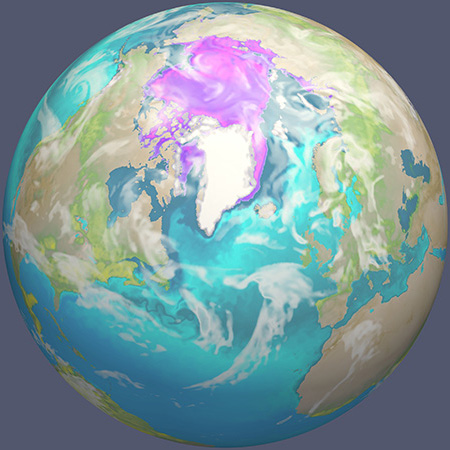ARM Data Provide Insights for Developing New High-Resolution Earth System Model
Published: 25 April 2018

After four years of development, including contributions from the Atmospheric Radiation Measurement (ARM) Research Facility, a new Earth modeling system—the Energy Exascale Earth System Model (E3SM)—is now available to the broader scientific community. The U.S. Department of Energy (DOE) Office of Science supports the E3SM project through the Office of Biological and Environmental Research.
Those involved with E3SM sought to overcome previous modeling limitations by taking advantage of the latest high-performance computing technologies. With this capability, the new high-resolution, coupled earth system model will help researchers explore the challenges posed by interactions of weather-climate variability with energy and related sectors.
“Our planet Earth represents an extraordinarily intricate set of systems,” says L. Ruby Leung, E3SM chief scientist from Pacific Northwest National Laboratory and principal investigator for the ARM Cloud Aerosol Precipitation Experiment (ACAPEX), a 2015 ARM field campaign. “To better understand individual systems, we simulate interactions and changes of key earth systems—atmosphere, oceans, land, and ice. We believe that E3SM is a state-of-the-science tool for holistically studying our planet.”
The project involves more than 100 scientists and engineers at multiple DOE national laboratories and universities, along with DOE programmatic contributions and collaborations.
Measurements from ARM’s Southern Great Plains, Tropical Western Pacific, and North Slope of Alaska atmospheric observatories were useful in constraining and guiding the development of representations of clouds and aerosols (tiny particles in the air) for the E3SM atmosphere model.
“Observation data are absolutely critical for providing insights on the processes that we are trying to model and for constraining uncertainty in the model parameterizations,” says Leung.
Adds David Bader, E3SM project lead and Lawrence Livermore National Laboratory scientist: “The quality and quantity of observations really makes us constrain the models. With the new system, we’ll be able to more realistically simulate the present, which gives us more confidence to simulate the future.”
Phase 2 of E3SM is expected to incorporate products developed under projects for the Climate Model Development and Validation (CMDV) activity, which is tasked to improve earth system model design and to develop scale-aware physics for earth systems and enhance model validation methods. Several of these projects require collaboration between E3SM, the ARM Facility, and DOE’s Atmospheric System Research program.
For more information on E3SM, read the Lawrence Livermore National Laboratory news release.
Watch a video about E3SM below.
The ARM Climate Research Facility is a DOE Office of Science user facility. The ARM Facility is operated by nine DOE national laboratories.
Keep up with the Atmospheric Observer
Updates on ARM news, events, and opportunities delivered to your inbox
ARM User Profile
ARM welcomes users from all institutions and nations. A free ARM user account is needed to access ARM data.


















